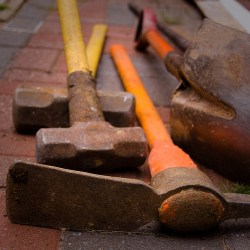
Photo by Mike Sheehan.
Not too long ago, we turned some of the most productive agricultural land in the world into suburbs. The business of building homes has slowed since the 2008 recession, but it continues to be true that no matter how well-suited a spot was to growing food, if a developer wants to make money, they’ll cover farmland with houses.
In the aftermath of the housing bubble, interesting signs have begun to suggest that the economics of dirt may be shifting. In fact it might one day be more valuable to grow food on a plot of land than to plop a house down on top of it. A few farmers recently made a killing buying back the farms they’d cashed out on. Meanwhile, the value of farmland in Iowa has increased by 33 percent, setting off speculation that farmland could be the next bubble. (It’s a bubble fueled by corn for ethanol and therefore food for cars instead of people, but still, it holds promise.) And then there is the matter of the failed shopping mall in Cleveland that began doing double-duty as a greenhouse.
All of this raises the question: What about those farms that have already been converted into subdivisions? Once someone has thoughtfully poured concrete over most of your neighborhood, should you try to un-concrete it and make it a farm again? Could the McMansions of Brentwood become fertile fields again?
Science says yes, absolutely. You wouldn’t want to tear up asphalt (it’s regrettably full of carcinogenic hydrocarbons), but concrete is a different story — and it’s fairly non-toxic. According to Garrison Sposito, chair of the soil sciences division at the University of California-Berkeley, the soil underneath can be unearthed, and put to work. But it will take time before it really comes back to life, he warns. Much of what makes soil grow plants well are creatures like worms and microfauna that would not have hung around under the sidewalk once most of the air and water disappeared. They would have hightailed it out of there.
That said, Sposito adds, the top foot of dirt in any urban area is never going to be great for farming at first. It could be filled with trash, construction debris, weedkiller, and lead from automobile exhaust. All these things require different levels of remediation; for instance lead is often treated with ground-up fish bones [PDF].
People looking to farm in urban areas say that smashing concrete and making way for food is possible, but with qualifications. “Most of the time you can simply use a sledgehammer and break it into chunks,” writes Patrick Crouch, who farms at Earthworm Farm in Detroit. “Then use a large steel bar to get underneath and pry it up.” Concrete, he adds, is heavy. “I have spent hours, no, days, breaking it up, and I can tell you that while there are certain enjoyable aspects of the process, most of it is back-breaking work.” The high alkalinity of the soil in Detroit is a direct result of being surrounded by so much concrete, according to Crouch. Quicklime, which is used in making cement, has a way of harshing the soil around it.
The largest lot Crouch has ever cleared, he says, was about two-thirds of an acre. The crew took a bulldozer and scraped the site down to the subsoil. They grew food the first year it was planted, but it took at least 12 years of composting and cover crops to get close to approximating anything like Crouch’s ideal of a good pile of dirt.
So, can it be done? Yes. Should you try it? That depends on how much you like hitting things with a sledgehammer. Or how effective you are at persuading other people to hit things with a sledgehammer. Either way, you won’t have to break up a layer of concrete more than once to gain a whole new appreciation for the importance of keeping fertile soil from being paved over in the first place.



